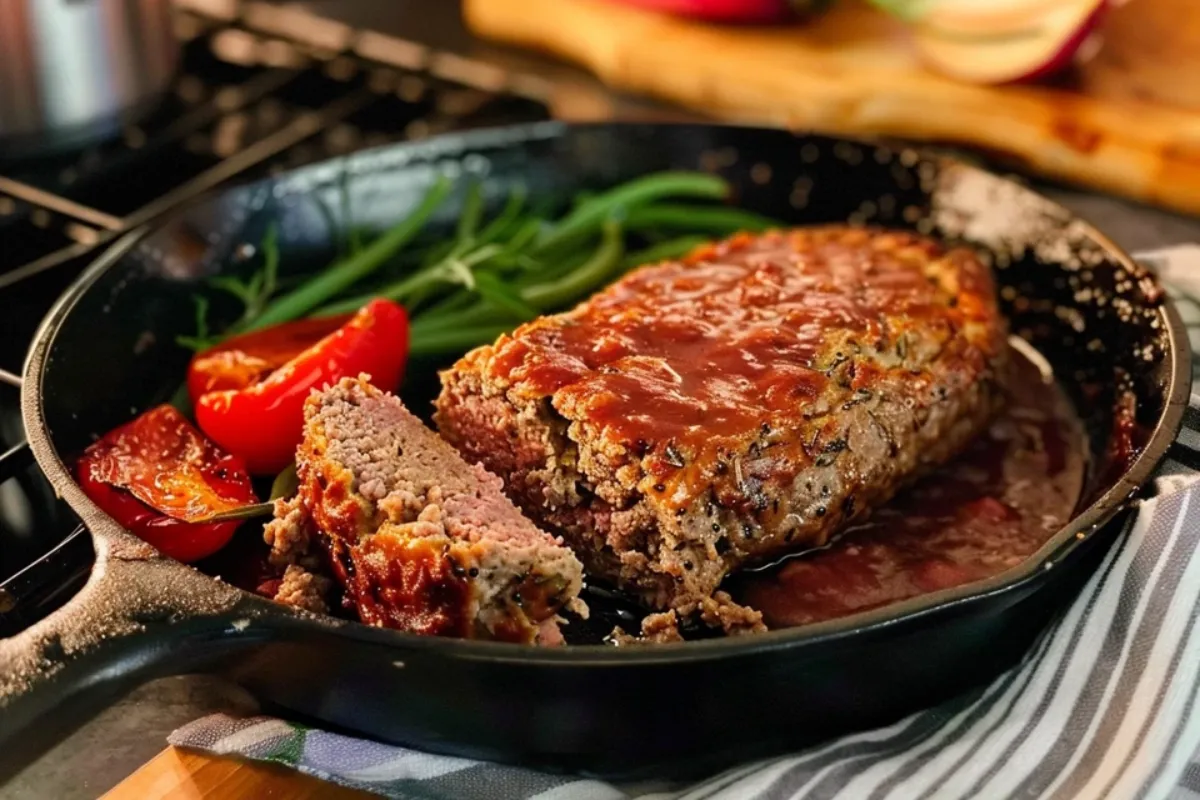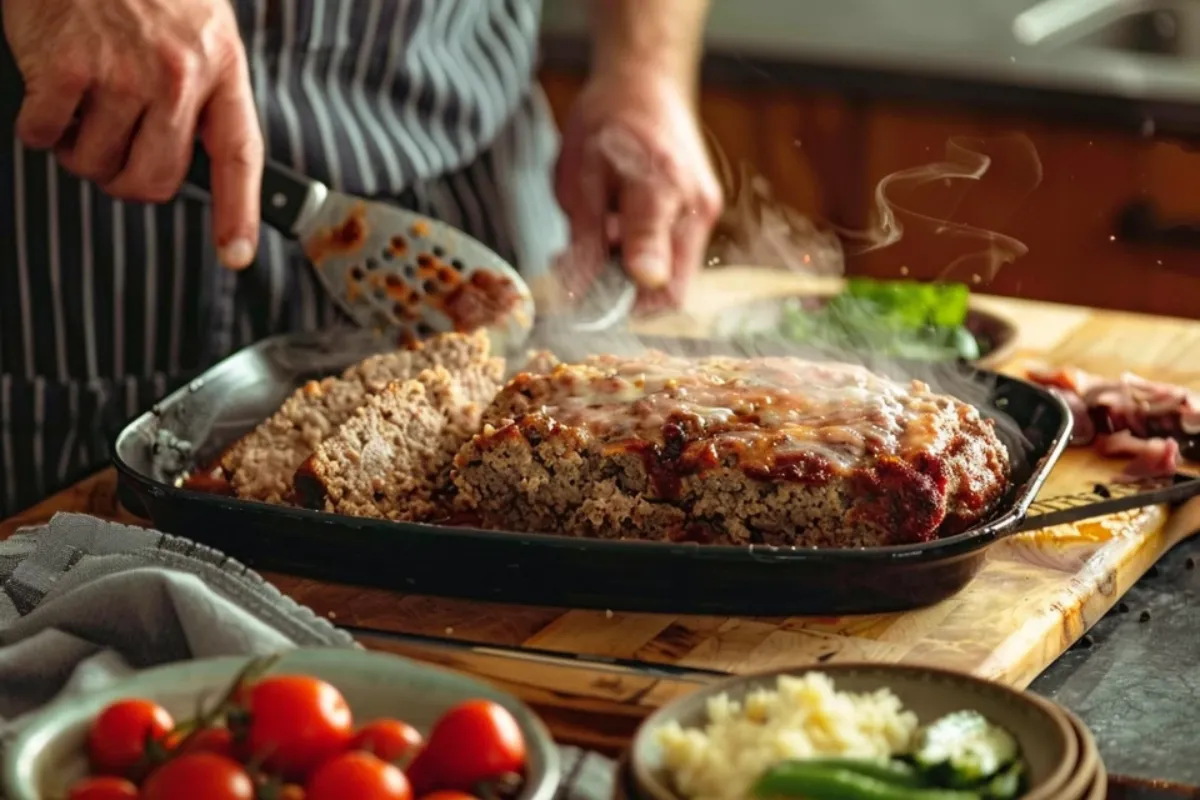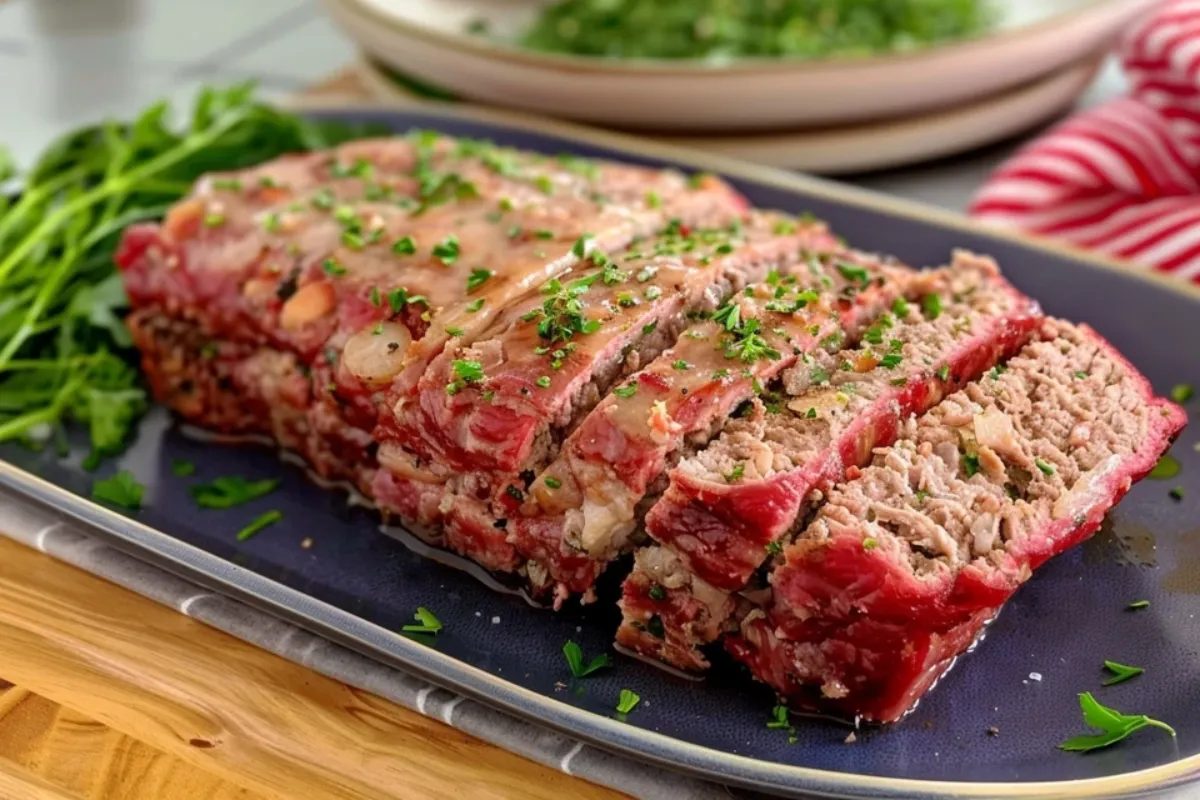Adding flavor to meat loaf naturally is easier than you might think. This article will guide you through simple, effective techniques to enhance your meat loaf’s taste profile naturally, without relying on artificial ingredients.
Enhancing Naturally Meat Loaf Flavor
Meat loaf, a classic comfort food, sometimes lacks that special something. However, you can easily elevate its flavor with natural ingredients. Let’s explore ways to achieve a robust and mouthwatering meat loaf. Therefore, we will delve into various techniques and ingredients.
The Importance of Quality Ingredients
The foundation of a flavorful meat loaf starts with good quality ingredients. First, consider using a blend of ground meats. For example, combine beef, pork, and veal for a richer taste. Naturally, fresh herbs and aromatics play a crucial role, as well.
Naturally Enhancing Flavor with Herbs and Spices
Herbs and spices are crucial for adding depth to your meat loaf. For example, incorporate fresh herbs like parsley, thyme, and oregano. Furthermore, use dried spices, such as garlic powder, onion powder, and paprika. In addition, consider adding a pinch of red pepper flakes for a subtle kick.
Fresh Herbs vs. Dried Herbs
Fresh herbs, while delightful, can be more delicate. However, dried herbs offer a more concentrated flavor. Consequently, it is best to use fresh herbs generously and adjust dried herbs accordingly. Therefore, always bloom dried spices in a little warm oil to release their full flavor.
Adding Moisture and Umami Naturally
Moisture and umami enhance the overall taste of the meat loaf. For example, use ingredients like milk-soaked breadcrumbs. Additionally, consider adding Worcestershire sauce, soy sauce, or tomato paste for an umami boost.
Using Breadcrumbs and Liquids
Breadcrumbs not only bind the meat loaf but also help retain moisture. Furthermore, soaking them in milk or broth beforehand yields a tender and juicy loaf. Accordingly, this prevents it from drying out during cooking.
The Role of Vegetables in Flavor
Finely chopped vegetables introduce both moisture and flavor. For instance, onions, carrots, and celery, when sautéed beforehand, bring a rich and savory sweetness. Therefore, this contributes to a more complex flavor profile. Additionally, consider incorporating roasted garlic or bell peppers.
Sautéed vs. Raw Vegetables
While raw vegetables offer a subtle crunch, sautéing them releases their sugars and enhances their flavor. Therefore, sauté them until they are softened but not browned. Then, add them to the meat mixture. In particular, this creates a deeper, sweeter base for the meat loaf.
Other Vegetable Additions
Additionally, consider adding finely chopped mushrooms. Furthermore, incorporate spinach for additional nutrients and subtle flavor. Likewise, these additions increase both the nutritional value and the taste. Indeed, the possibilities are endless.
Binding Ingredients for Better Texture
Eggs and breadcrumbs bind the meat loaf, ensuring it holds together. However, too much egg can make the meat loaf dense. Therefore, a balance is key. Also, the moisture from soaked breadcrumbs prevents a dry result. Thus, these ingredients play an important role in creating the ideal consistency.
The Importance of Eggs
Eggs provide essential binding properties. Also, they help create a cohesive meat mixture. Therefore, incorporate eggs in moderation. Additionally, consider using a flax egg substitute for a vegan option.
Understanding Breadcrumbs
Breadcrumbs help the meat loaf maintain its moisture. Furthermore, they act as a binding agent. Therefore, ensure that the breadcrumbs are properly soaked before adding to the mixture. Likewise, this ensures a tender result.
Flavorful Add-Ins for Unique Tastes
Consider adding ingredients for a unique twist. For example, cheese, bacon, or even olives can significantly alter the flavor profile of your meat loaf. However, add these judiciously.
Cheese Selection
Adding cheese can introduce creaminess and depth. For instance, cheddar, mozzarella, and parmesan are great choices. Additionally, consider using a blend for a more complex flavor. Furthermore, always ensure the cheese is grated finely for even distribution.
Meats and other add-ins
Moreover, adding cooked bacon or pancetta enhances the savory flavor. Additionally, consider adding chopped sun-dried tomatoes. Similarly, olives and roasted peppers offer a burst of briny or sweet flavors.
Seasoning Techniques for a Flavorful Meatloaf
Seasoning is crucial for a well-flavored meat loaf. Therefore, season the meat mixture generously. Then, adjust as needed. Furthermore, season during different phases of mixing. Thus, this ensures the flavors are well incorporated.
Salting and Peppering
Salt and pepper are essential. Likewise, they enhance all other flavors. Therefore, season early and often. Also, taste the mixture before baking and adjust. Furthermore, consider using freshly ground pepper for a more intense flavor.
Pre-Seasoning Techniques
In addition, seasoning your ground meats separately before mixing can enhance the flavor even more. Thus, this is a great way to ensure the seasonings are distributed throughout. Likewise, bloom your dried spices in a little bit of oil before adding.
Cooking Methods and Flavor
The cooking method also affects the flavor of your meat loaf. For example, baking is the most common method. However, searing or smoking can add layers of flavor. Consequently, cooking temperature and time are important. Thus, use an oven thermometer.
Baking at the Right Temperature
Baking at the right temperature is essential for a perfectly cooked meat loaf. In addition, use an oven thermometer to maintain a consistent temperature. Thus, this will ensure the meat loaf is cooked evenly. Therefore, a temperature of 350°F (175°C) is generally ideal.
Searing the Meat Loaf
Searing the meat loaf before baking can enhance its flavor. Furthermore, it creates a delicious crust. Therefore, sear it quickly over high heat in an oven-safe pan before baking it. Accordingly, this will seal in the juices and add a wonderful texture.
Table 1: Common Meat Loaf Add-Ins and Their Benefits
| Add-In | Benefit | Flavor Contribution |
| Onions | Adds moisture and sweetness | Savory and slightly sweet |
| Garlic | Enhances overall flavor | Pungent and aromatic |
| Carrots | Adds natural sweetness and moisture | Sweet and earthy |
| Celery | Adds subtle flavor and texture | Mildly herbaceous and slightly salty |
| Mushrooms | Adds umami and richness | Earthy and savory |
| Spinach | Adds nutrients and mild flavor | Slightly earthy and green |
| Cheese (Cheddar) | Adds creaminess and richness | Sharp and nutty |
| Bacon/Pancetta | Adds smoky and salty flavor | Smoky, salty, and savory |
| Sun-Dried Tomatoes | Adds a tangy and intense flavor | Sweet, tangy, and slightly acidic |
| Worcestershire Sauce | Adds umami and depth | Savory, tangy, and umami |
| Soy Sauce | Adds umami and saltiness | Salty and savory |
| Tomato Paste | Adds umami and sweetness | Concentrated tomato flavor with some sweetness |
Serving and Pairing Suggestions
The presentation and pairings can significantly enhance the eating experience. For instance, serve slices of meat loaf with a flavorful sauce. Moreover, consider side dishes that complement the flavors. Therefore, the right accompaniments can elevate your meal.
Complementary Sauces
A tangy tomato-based sauce perfectly complements meat loaf. Additionally, consider a mushroom gravy or a balsamic glaze. Therefore, choose a sauce that enhances the overall flavor profile of your meat loaf. Likewise, offer several options for diverse tastes.
Side Dish Ideas
Mashed potatoes, roasted vegetables, or a simple salad work well with meat loaf. Moreover, consider serving it alongside green beans, carrots, or broccoli. Consequently, this provides a balanced meal. Also, cornbread is a delightful addition.
The Science of Flavor
Understanding flavor is complex. Indeed, it is influenced by taste, smell, and texture. Thus, when you are cooking, consider all these aspects. However, this approach will help you develop a truly exceptional dish. In addition, experimenting with various spices can be eye-opening.
Taste and Smell Interaction
Taste and smell work together to create flavor. Thus, aromatic compounds in ingredients play a crucial role. Therefore, using fresh, high-quality ingredients enhances this interaction. Likewise, cooking methods can impact these compounds.
Understanding Texture’s Role
Texture affects how we experience flavor. Indeed, a tender and moist meat loaf is more enjoyable. Therefore, focus on using the right binding agents. In addition, use adequate moisture. Furthermore, don’t overcook your meat loaf.
Storage and Reheating
Proper storage and reheating techniques are necessary. Also, this will help maintain the quality and flavor of your meat loaf. Additionally, store leftovers in an airtight container in the refrigerator for up to three days. Then, always reheat thoroughly before serving.
Refrigeration Tips
Store your meat loaf in an airtight container. In addition, keep it separate from other foods. Moreover, use within 3 days for optimal freshness. Subsequently, this will help maintain the quality and flavor.
Reheating Instructions
Reheat slices of meat loaf gently in a pan with a little broth. Alternatively, use an oven at a lower temperature. Consequently, avoid overcooking. Therefore, this will maintain the texture. Likewise, ensure it is heated through to a safe temperature.
Table 2: Flavor Enhancement Techniques
| Technique | Description | Flavor Outcome |
| Sautéing vegetables | Cooking vegetables in fat until softened | Enhances sweetness and savory notes |
| Blooming spices | Heating dried spices in oil to release aromas | Intensifies flavor and fragrance |
| Adding Umami-Rich Ingredients | Including ingredients like soy sauce or Worcestershire sauce | Adds savory depth and complexity |
| Using fresh herbs | Adding fresh herbs at the end of cooking | Brightens and enhances flavor |
| Pre-seasoning | Seasoning individual components before combining | Ensures even distribution of flavors |
| Searing the meatloaf before baking | Briefly cooking the exterior of the meatloaf before baking | Adds texture and depth of flavor |
Troubleshooting Common Issues
Sometimes, things might not go according to plan. Therefore, addressing common issues can help you consistently produce great meat loaf. For instance, a dry meat loaf can result from overcooking. However, blandness can stem from insufficient seasoning.
Avoiding a Dry Meat Loaf
To prevent a dry meat loaf, ensure sufficient moisture. Also, use milk-soaked breadcrumbs and don’t overbake. Furthermore, consider adding vegetables that release moisture. Indeed, this ensures a tender and juicy result.
Fixing Bland Flavor
To fix a bland meat loaf, increase the seasoning. In addition, incorporate flavorful additions. Consequently, this enhances the overall taste. Furthermore, consider adding a flavorful sauce or glaze. Indeed, you can fix blandness easily.
Variations for Dietary Needs
Adapt the meat loaf recipe to suit dietary needs. For example, use gluten-free breadcrumbs for those with gluten sensitivities. Similarly, you can make a vegetarian version by substituting ground meat with lentils or mushrooms. Thus, everyone can enjoy a great meat loaf. Therefore, consider these variations.
Conclusion
Adding flavor to meat loaf naturally involves a combination of carefully selected ingredients and cooking techniques. By using fresh herbs, sautéed vegetables, and umami-rich additions, you can create a truly delicious meal. Additionally, pay attention to seasoning and moisture for the best results. Moreover, don’t be afraid to experiment. Furthermore, the goal is to enhance the natural flavors. Consequently, this will ensure that your meat loaf is both flavorful and satisfying.
Frequently Asked Questions (FAQs)
Why does my meatloaf taste bland?
A bland meatloaf often results from insufficient seasoning or a lack of flavorful ingredients. Therefore, ensure you’re adding enough salt, pepper, and other herbs and spices. Additionally, try adding umami-rich ingredients like Worcestershire sauce, soy sauce, or tomato paste. Also, sautéing vegetables like onions and garlic before adding them to the meat mixture can greatly enhance the taste.
What does adding an extra egg to meatloaf do?
Adding an extra egg to meatloaf can make it denser and more compact. Also, while eggs act as a binding agent, too many can make the meatloaf tough. Therefore, use eggs in moderation to prevent a rubbery texture. Generally, one to two eggs are sufficient for a standard meatloaf recipe.
How do you add flavor to cooked meat?
You can add flavor to cooked meat in several ways. For example, consider basting it with a flavorful sauce during the last few minutes of cooking. In addition, using a seasoned pan sauce can also help. Additionally, marinating cooked meat or serving it with a flavorful gravy enhances the overall experience. Moreover, consider using a finishing salt to add a final touch of flavor.
What does adding milk to meatloaf do?
Adding milk to meatloaf, especially when soaking breadcrumbs in it, provides much-needed moisture. Furthermore, this helps in making the meatloaf tender and juicy. Therefore, the milk-soaked breadcrumbs also help to bind the meatloaf mixture, preventing it from being dry. Consequently, this is a common technique to ensure the meatloaf is not tough.


